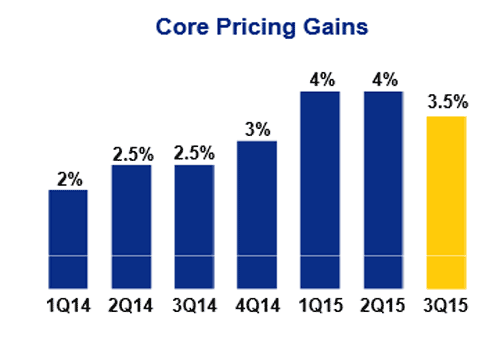From SCDigest's On-Target E-Magazine
- Nov. 16, 2015 -
Supply Chain News: Rail Carriers See Volumes Drop in Q3, but Rates, Profits Again Stay Strong
A Detailed Look at Rail Carrier Results and Trends in Q3 2015
SCDigest Editorial Staff
US rail carriers saw carload volumes decrease in Q3, perhaps partly due to trucking becoming more cost competitive with rail, but that didn't stop rates from heading up or strong profits at major rail carriers.
SCDigest Says: |

Union Pacific, which reports pricing gains each quarter, saw 3.5% core rates increases in Q3, down a bit from the previous couple of quarters but above Q3 2014 levels. |
| |
|
What Do You Say?
|
|
|
|
We're back as usual every quarter with our review of the results and trends across freight modes, starting last week with US truckload carriers (see US Truckload Carriers Enjoy Generally Strong Q3, Finally Starting to Add Capacity.)
This week, we look at the rail transport sector, and then next week we'll review results and trends in the less-than-truckload group.
Here we look at the four major Class I public carriers that make up the US rail sector (Burlington Northern is of course part of public company Berkshire Hathaway, but its results are not broken out in any detail and thus are not included).
In general, it has been a somewhat tough year for rail carriers. An unweighted average of the carriers we follow showed car load volumes down 3.6% in Q3. Much of that came from declines in coal shipments once again hitting hard, with coal car loads down 15-21% at all carriers except Kansas City Southern, which had only a 1% decrease in coal shipments.
The Association of American Railroads says that through the end of Q3, total rail car loads and intermodal units were down 1.1% versus 2014, with regular car loads down 4.4% and intermodal units up 2.5%, though that is slow growth compared to most recent years.
One factor is lower diesel fuel costs, which are making trucking more competitive with rail for long distance moves.
"I think you look at what's going on currently in the trucking environment, the lower fuel cost is allowing trucks to be more competitive vis-a-vis rail, just by virtue of that fact," said Eric Butler, Union Pacific's executive vice president of marketing and sales, on the carriers Q3 earnings call.
But despite those sluggish volumes, rail carriers were still able to push rates up fairly strongly. Deutsche Bank analysts estimate that rail carrier rate increases, net of
fuel, were 3.7% year-over-year in the third quarter, probably down a bit from Q2 but still positive for rail carriers in the face of weak demand. (See full results table below.)
Union Pacific, which reports pricing gains each quarter, saw 3.5% core rates increases in Q3, down a bit from the previous couple of quarters but above Q3 2014 levels.
Changes in Core Pricing at Union Pacific in Recent Quarters

Source: Union Pacific
Average operating ratios (OR), or operating expense divided by operating revenue, a key metric in the transport sector, were down again in Q3, decreasing 0.4 percent points to 65.9% (unweighted average) from 66.3% in 2014. That level of OR is of course far superior to that seen in the truckload or LTL sectors, which generally see ORs in the high 80 percent levels and low 90 levels, respectively.
Union Pacific achieved an amazing OR of just 60.3%.
While net income for the group was down 4.3%, net income as a percent of revenue was actually up at 20.8% from 19.6% in 2014, led as usual by Union Pacific, at a robust 22.2%. By comparison, profit as a percent of revenue was just 5% at Ford in Q3, and 15.8% at Procter & Gamble. Apparently, railroads are where you make the money these days.
(Transportation Management Article Continued Below)
|